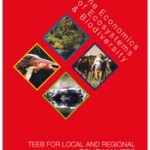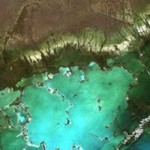 Along the south Kona coast of Hawaii, moisture gently sweeps in from the ocean. The looming volcanoes Mauna Loa and Mauna Kea protect fields from harsher weather patterns, making the landscape well-suited to growing crops.
Along the south Kona coast of Hawaii, moisture gently sweeps in from the ocean. The looming volcanoes Mauna Loa and Mauna Kea protect fields from harsher weather patterns, making the landscape well-suited to growing crops.
Further north, on Kohala volcano, however, the conditions are not so favorable. The trade winds howl. The mountain’s rain shadow creates one of the most extreme rainfall gradients in the world. A rainforest envelops the summit while barren lava covers the coast less than 12 miles away.
Yet despite these stark differences in local climate, at both Kona and Kohala, the landscape is lined with unassuming piles of earth. Recent evidence suggests that these earth mounds, ranging from 12 to 36 inches high, played a significant role in Hawaiian agriculture.
Noa Lincoln, a native Hawaiian and Ph.D. student in the Emmett Interdisciplinary Program in Environment and Resources at Stanford University, studies native Hawaiian agricultural systems. At the Stanford School of Earth Sciences research review this spring, he presented results that explain how Hawaiians adapted to their landscape and built these small earth mounds to provide water to their crops in dry, windy Kohala and protect crops from the sun in Kona.
A research team on the Big Island over the past summer – including Lincoln, his advisor Peter Vitousek, and groups of undergraduate students – tested the importance of these mounds for trapping water in Kohala. After clearing vegetation above and below the mounds, the team waited to see what would happen. To their surprise, these small mounds made a big difference. On the side of the mounds facing the wind, grasses and weeds sprouted, while on the side facing away the soil remained dry and bare.
Their observation raised more questions – why were the earth mounds having such a large impact on the environment? The team measured moisture in the soil and found that there was significantly more water on the side of the mound facing the wind – as much as three times more water. Wind coming down over Kohala volcano carries water as mist and rarely falls as rainfall. Barriers like these mounds trap some of this mist and increase the water in the soil, making it available to crops.
After this first experiment, Lincoln began to see synergies between these results and his knowledge of native Hawaiian practices. The team hypothesized that this water-capturing effect might explain why Hawaiians planted sugarcane along the mounds. They are now putting this indigenous wisdom into practice and recreating what native Hawaiians describe as the “long lines of cane in Kohala”. At three locations on Kohala volcano, the team has fenced off small plots where they are testing the impact of sugarcane plantings on water availability.
Native Hawaiians sustained agriculture on their land for about 400 years before European contact decimated the population and destroyed what appear to have been massive, labor-intensive agricultural systems. To Lincoln’s eye, these field systems look like “the organization of a nation”.
It is striking that Hawaiians must have sustained a greater population than is currently present on the Big Island, simply by adapting to their landscape.
Much of the research now is focused on trying to understand how known agricultural practices contributed to this long-term sustainability. Adelaide Oneal, an undergraduate at Stanford, worked with Lincoln over the summer adding mulch to the Kona fields. Researchers know that native Hawaiians used such practices, but don’t necessarily understand how they contributed to soil productivity. By systematically repeating native Hawaiian techniques, the team hopes to figure out why the Hawaiians used these practices and what benefits they derived from them. Their work relies on native knowledge but also on the rigors of systematic, scientific analysis.
“I just see it as the only way to investigate it in a clear way,” Oneal said.
In a world facing numerous agricultural challenges, native Hawaiian agriculture provides a lesson in adaptation and sustainability. However, Lincoln said that he studies native Hawaiian agriculture not to apply these specific practices elsewhere, but to better understand how humans can work with the land.
“Rather than impose the same solution everywhere, we need to understand best practices in the context of our environment,” Lincoln said.
Source: By Elise Post, Peninsula Press/Stanford.













